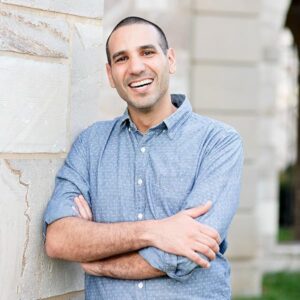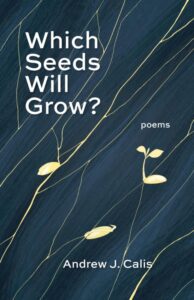Andrew Calis find hope in a hopeless land.
A friend recommend I read the poetry of Andrew Calis, and I soon discovered I was gingerly wading into one of the most contentious realities imaginable – the Mideast.
Andrew Calis is a poet whose work has been featured in Dappled Things, The Atlantic, and several other literary publications. He’s published two poetry collections, Pilgrimages in 2020 and Which Seeds Will Grow? just last month. He has a Ph.D. degree in English Literature from the Catholic University of America. He’s a high school English teacher and lives with his family in Maryland.
He’s also a member of a family that belongs to what is the most overlooked group in conflict in the Mideast – Palestinian Christians. I knew of their existence, of course, but I knew little about them. So, I started my research.

Andrew Calis
Like everything else about the Mideast, it’s not easy for an amateur researcher to find balanced accounts. But I did learn about a general diaspora of many Palestinian Christians to other parts of the world, including Canada, the United States, and Australia. That’s the diaspora Calis’s family is part of.
Once in America, his father would not allow the speaking of Arabic within the family so the children would only have American accents. The poet in the family speaks and writes like an American poet, but he writes with a sensitivity and intensity not usually present in “American” poetry.
In Which Seeds Will Grow?, Calis initially writes through the lens of the natural world, and it’s there he finds hope in what too often looks like a hopeless reality. Whether he’s writing about rain, the earth, the stars, a storm birds, which occupy the first of the collection’s three parts, he’s writing about hope.
That theme of hope becomes more obvious in the second and third parts of the collection. It’s something of an achievement to look at a bleak landscape that seems never-ending and still find hope, but that’s what Calis does repeatedly. The hope comes from his faith, and he expresses hope and faith with a clear, loving eye.
Scars and Stillness

where its branches grew. And I knew
this disappointing thing, death, loomed larger
than it should – just black-ashed wood and leaf. How few
sadnesses remain. This one
somehow did. I couldn’t shake the memory –
the dark edges, teethed like jagged bones,
the deadened black wood, the fresh-lost green,
like Golgotha, somehow – the lifelessness of stone.
I look across the yard, cross it
looking for vague comfort, some mound
of life, some true movement: birds, a line of sun-
light so alive with hope it buzzes with sound;
nothing. I rest here, sunk
in silence that sweeps into new air –
the stillness moving toward me like a prayer.
Like “Scars and Stillness,” the poems of Which Seeds Will Grow? convey the understanding of a place where reconciliation and resolution seem impossible. From a human perspective, both are indeed likely impossible, at least in a peaceful way. But Calis reaches for something beyond human understanding, and he sees the light still shining in the darkness.
Photo by Gabriel Caparo, Creative Commons, via Flickr. Post by Glynn Young.
How to Read a Poem uses images like the mouse, the hive, the switch (from the Billy Collins poem)—to guide readers into new ways of understanding poems. Anthology included.
“I require all our incoming poetry students—in the MFA I direct—to buy and read this book.”
—Jeanetta Calhoun Mish
- “Horace: Poet on a Volcano” by Peter Stothard - September 16, 2025
- Poets and Poems: The Three Collections of Pasquale Trozzolo - September 11, 2025
- Poets and Poems: Boris Dralyuk and “My Hollywood” - September 9, 2025


Sandra Heska King says
“the stillness moving toward me like a prayer”
Just letting those words soak in.
Thanks, Glynn.